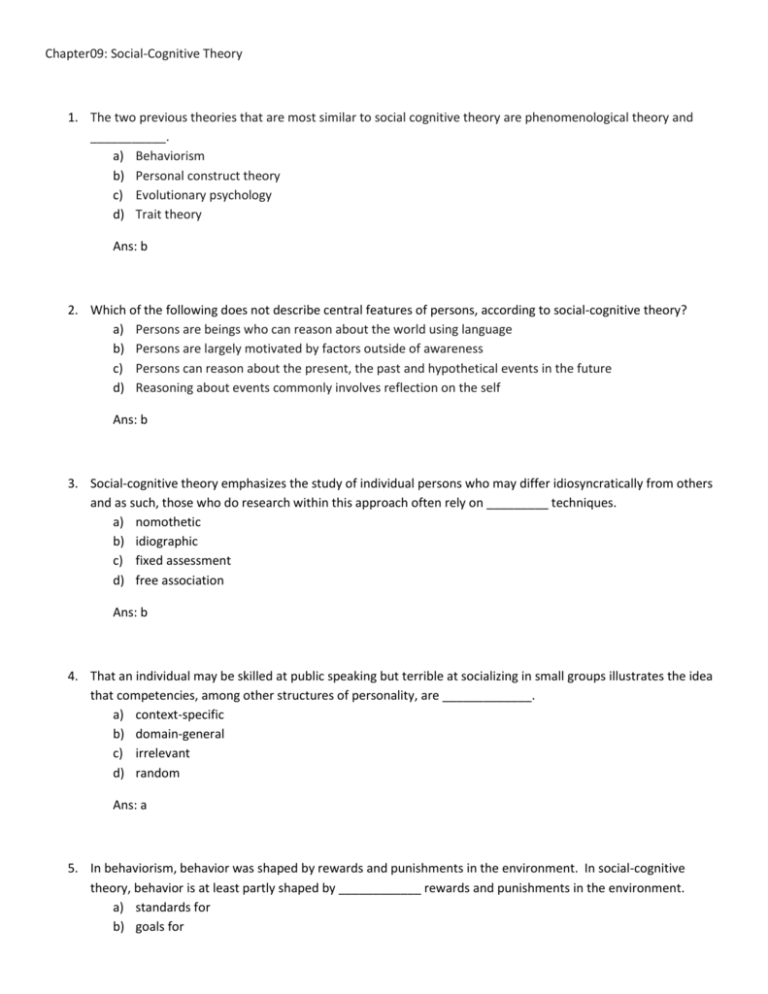Chapter09: Social-Cognitive Theory The two previous theories that
advertisement

Chapter09: Social-Cognitive Theory 1. The two previous theories that are most similar to social cognitive theory are phenomenological theory and ___________. a) Behaviorism b) Personal construct theory c) Evolutionary psychology d) Trait theory Ans: b 2. Which of the following does not describe central features of persons, according to social-cognitive theory? a) Persons are beings who can reason about the world using language b) Persons are largely motivated by factors outside of awareness c) Persons can reason about the present, the past and hypothetical events in the future d) Reasoning about events commonly involves reflection on the self Ans: b 3. Social-cognitive theory emphasizes the study of individual persons who may differ idiosyncratically from others and as such, those who do research within this approach often rely on _________ techniques. a) nomothetic b) idiographic c) fixed assessment d) free association Ans: b 4. That an individual may be skilled at public speaking but terrible at socializing in small groups illustrates the idea that competencies, among other structures of personality, are _____________. a) context-specific b) domain-general c) irrelevant d) random Ans: a 5. In behaviorism, behavior was shaped by rewards and punishments in the environment. In social-cognitive theory, behavior is at least partly shaped by ____________ rewards and punishments in the environment. a) standards for b) goals for c) expectancies about d) none of the above Ans: c 6. People with high self-efficacy beliefs on a task will do all of the following except which one? a) Attempt difficult tasks b) Be persistent in one’s efforts c) Overthink the utility of the task d) Stay calm during task performance Ans: c 7. In using a microanalytic research strategy to study self-efficacy, a researcher would ask people to indicate their degree of certainty in performing _________behaviors in _________contexts. a) specific; all b) specific; designated c) general; all d) general; designated Ans: b 8. Cervone and Peake (1986) used an anchoring technique to manipulate ____________. a) self-efficacy b) skill c) self-esteem d) optimism Ans: a 9. Research indicates that _____________ goals are often more motivating than ____________ goals because they decrease the probability of slacking off. a) proximal; distal b) proximal; learning c) distal; learning d) distal; proximal Ans: a 10. Self-evaluative reactions refer to the _______________ reactions that are triggered when we evaluate our ongoing behavior in light of our personal standards for performance. a) cognitive b) social c) physical d) emotional Ans: d 11. Reciprocal determinism is the concept that personality, behavior, and the environment must be understood as a system of forces that __________influence one another. a) sort of b) barely c) mutually d) quickly Ans: c 12. Shoda, Mischel, and Wright’s (1996) research supported the CAPS model by demonstrating that behavior varied across____________. a) time b) situations c) cohorts d) historical periods Ans: b 13. In Shoda, Mischel, and Wright’s (1996) research, the distinctive patterns of within-person variability in behavior were called _______________. a) behavioral signatures b) cognitive affects c) cognitive-affective processing systems d) verbal aggression Ans: a 14. The effects of modeling run counter to the Skinnerian belief that individuals must be directly ___________ for learning to occur. a) taught b) instructed c) reinforced d) spoken to Ans: c 15. In one of his “Bobo doll” studies, Bandura (1965) manipulated whether children were offered incentives for modeling a target’s behavior. He did this to demonstrate the distinction between acquisition and ________. a) reinforcement b) performance c) instruction d) imitation Ans: b 16. Bandura’s work on vicarious conditioning suggests that even ________ responses can be learned through observing others. a) logical b) systematic c) emotional d) verbal Ans: c 17. Which of the following statements about self-regulation and social-cognitive theory is true? a) Self-regulation involves only goals. b) Self-regulation involves only goals and evaluative standards c) Self-regulation involves only competencies and evaluative standards d) Self-regulation involves all of the social-cognitive structures, including goals, standards, and expectancies. Ans: d 18. Bandura and Cervone’s (1983) experiment demonstrated the influence of __________ and __________ on motivation. a) goals; feedback b) goals; competencies c) feedback; competencies d) feedback; self-esteem Ans: a 19. Mischel and colleagues’ research using the delay of gratification demonstrates that children are best able to delay gratification when _________________. a) rewards are covered up only b) they use cognitive strategies only c) the rewards are covered up and they use cognitive strategies d) none of the above Ans: c 20. Mischel’s research on the continuity of delay of gratification scores indicates that they predict __________. a) cognitive skills in adolescence b) self-control skills in adolescence c) SAT scores in adolescence d) all of the above Ans: d








